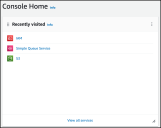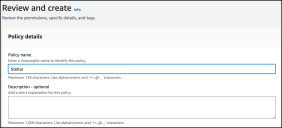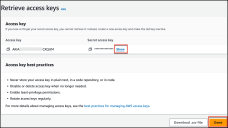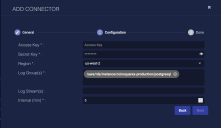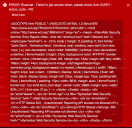Configuring AWS CloudWatch Connectors
The AWS CloudWatch connector allows Stellar Cyber to collect
AWS ECS/EKS,
Although the AWS CloudWatch connector may successfully import other logs, only AWS Elastic Container Service (ECS)/Elastic Kubernetes Service (EKS),
You can use an AWS CloudWatch connector to ingest logs from Amazon GuardDuty findings by exporting those logs to your AWS CloudWatch service. Refer to Amazon's documentation for configuration of this export: https://docs.aws.amazon.com/guardduty/latest/ug/guardduty_exportfindings.html .
Connector Overview: AWS CloudWatch
Capabilities
-
Collect: Yes
-
Respond: No
-
Native Alerts Mapped: No
-
Runs on: DP
-
Interval: Configurable
Collected Data
|
Content Type |
Index |
Locating Records |
|---|---|---|
|
N/A |
Syslog |
Domain
|
https://logs.<Region>.amazonaws.com/ where <Region> is a variable from the configuration of this connector |
Response Actions
N/A
Third Party Native Alert Integration Details
N/A
Required Credentials
-
For Access Key / Secret Key authentication: Access Key and Secret Key, plus Region, and Log Group(s)
Let us know if you find the above overview useful.
Adding an AWS CloudWatch Connector
To add an AWS CloudWatch connector:
- Add an AWS user
- Create an access key
- Identify CloudWatch log groups
- Add the connector in Stellar Cyber
- Test the connector
- Verify ingestion
Adding an AWS User for Stellar Cyber

Use our example as a guideline, as you might be using a different software version.
To add a user with the appropriate permissions:
-
Log in to your AWS Management Console at https://aws.amazon.com/console. View the services in the Console Home or choose View all services.
-
Choose IAM. The IAM Dashboard appears.
-
Choose Policies and then choose Create Policy.
-
In the Create policy pane, choose the JSON tab.
-
Using the example below as a guide, edit the JSON policy document.
The following is just an EXAMPLE. You must modify this JSON to match the resources in your own environment.
CopyCloudWatch policy{
"Version": "2012-10-17",
"Statement": [
{
"Sid": "VisualEditor0",
"Effect": "Allow",
"Action": [
"logs:DescribeLogGroups",
"logs:DescribeLogStreams",
"logs:GetLogEvents",
"logs:FilterLogEvents"
],
"Resource": "*",
"Condition": {
"ForAnyValue:StringEquals": {
"aws:RequestedRegion": "us-west-2"
}
}
}
]
} -
Choose Next.
-
Give your policy a name to associate it with Stellar Cyber, then choose Create policy.
The policy can now be attached to a user.
-
From the IAM navigation pane, choose Users and then choose Create user.
-
In the Specify user details page for User details, enter a User name for the new user.
-
Choose Provide user access to the – AWS Management Console optional to produce login credentials for the new user, such as a password.
-
Choose how you want to create the Console password and then choose Next.
-
For Set permissions, choose Attach policies directly. Then search for the policy you created above.
-
Select the checkbox to the left of the policy name, then choose Next.
-
Verify the information and then choose Create user.
Creating an Access Key
For Access Key / Secret Key authentication, you will need the access key and secret key when configuring the connector in Stellar Cyber.
-
Log in to the IAM Console with your AWS account ID, your IAM user name, and password. You must have the permissions required to create access keys for a user.
-
Choose Users, then choose the user name, and click Security credentials.
-
In the Access keys section, choose Create access key. Access keys have two parts: an access key ID and a secret access key. Click Create access key.
-
On the Access key best practices & alternatives page, choose Other and then choose Next.
-
Click Create access key.
-
On the Retrieve access keys page, choose Show to reveal the value of the user's secret access key. Save the access key ID and secret access key in a secure location. You will need them when configuring the connector in Stellar Cyber.
-
Click Done.
Identifying AWS CloudWatch Log Groups
For this connector, you will specify one or more log groups to ingest. Use this procedure to locate the group names (this procedure assumes that you have already configured your CloudWatch instances and log groups).
-
Log in to your AWS CloudWatch Console at https://console.aws.amazon.com/cloudwatch/ .
-
Navigate to the Logs section of the left hand navigation pane.
-
Select Log Groups.
-
Make note of the groups you want to ingest to Stellar Cyber.
Adding the Connector in Stellar Cyber
With the credential and log information available, you can now add the AWS CloudWatch connector in Stellar Cyber:
-
Log in to Stellar Cyber.
-
Click System | Integration | Connectors. The Connector Overview appears.
-
Click Create. The General tab of the Add Connector screen appears. The information on this tab cannot be changed after you add the connector.
The asterisk (*) indicates a required field.
-
Choose PaaS from the Category drop-down.
-
Choose AWS CloudWatch from the Type drop-down.
-
For this connector, the supported Function is Collect, which is enabled already.
-
Enter a Name.
This field does not accept multibyte characters.
-
Choose a Tenant Name. The Interflow records created by this connector include this tenant name.
-
Choose the device on which to run the connector.
-
(Optional) When the Function is Collect, you can create Log Filters. For information, see Managing Log Filters.

-
Click Next. The Configuration tab appears.
The asterisk (*) indicates a required field.
-
For Access Key / Secret Key authentication:
-
Enter the Access Key you noted above in Creating an Access Key.
-
Enter the Secret Key you noted above.
-
-
Choose a Region from the available regions in the drop-down.
-
Enter the Log Group(s) as named in your AWS CloudWatch console. To enter multiple log group names, press Enter after each name.
If you want to enter Log Stream(s) in the optional step below, you can only enter one Log Group in this step.
-
(Optional) Enter the Log Stream(s). Provide a list of log stream(s) that correspond to the provided log group. To enter multiple log stream names, press Enter after each name. If log streams are not specifically listed, every log stream within the provided log group is automatically searched.

-
Choose the Interval (min). This is how often the logs are collected.
-
Click Next. The final confirmation tab appears.
-
Click Submit.
To pull data, a connector must be added to a Data Analyzer profile if it is running on the Data Processor.
The new connector is immediately active and starts collecting logs.
Testing the Connector
When you add (or edit) a connector, we recommend that you run a test to validate the connectivity parameters you entered. (The test validates only the authentication / connectivity; it does not validate data flow).
For connectors running on a sensor, Stellar Cyber recommends that you allow 30-60 seconds for new or modified configuration details to be propagated to the sensor before performing a test.
-
Click System | Integrations | Connectors. The Connector Overview appears.
-
Locate the connector that you added, or modified, or that you want to test.
-
Click Test at the right side of that row. The test runs immediately.
Note that you may run only one test at a time.
Stellar Cyber conducts a basic connectivity test for the connector and reports a success or failure result. A successful test indicates that you entered all of the connector information correctly.
To aid troubleshooting your connector, the dialog remains open until you explicitly close it by using the X button. If the test fails, you can select the button from the same row to review and correct issues.
The connector status is updated every five (5) minutes. A successful test clears the connector status, but if issues persist, the status reverts to failed after a minute.
Repeat the test as needed.
Verifying Ingestion
To verify ingestion:
- Click Investigate | Threat Hunting. The Interflow Search tab appears.
- Change the Indices to Syslog. The table immediately updates to show ingested Interflow records.
